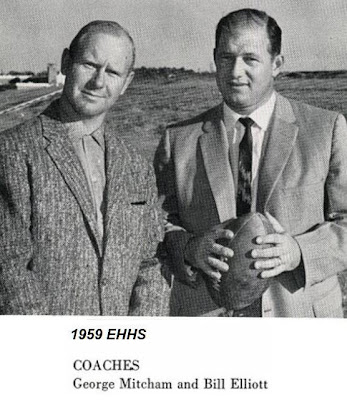During the time we attended EH, our experience was
influenced by a number of different individuals…classmates, teachers, coaches,
K.O. Vaughn, and Roy Johnson, conspicuous among them. And for boys, certainly those participating
in organized sports, perhaps the most memorable of those influences were the
coaches. They shaped the character of our
teams and set the agenda for many, many hours and months of our lives. And as described in my Dub Graves article,
they could also contribute something of a vision for the future.
This brief essay chronicles the early history of the first EH varsity football coaching staff, including a few subtle changes, and ending with their eventual departure after the 1967 season. Most of us had an experience with them that lasted only 1-3 years, then left for college or life, and never returned, or if we did, it was an infrequent visit to a school that no longer reflected the one we had known.
1959-60, Year 1.
Coach George Mitcham got the job as Eastern Hills’ first
head coach. Bill Ellliott joined him that
first year as assistant coach as Eastern Hills competed in the 3A district that
year. Elliott had been Mitcham’s
assistant at Handley High
School for several years during the 1950s. After this one season, Bill Elliott returned
to Handley Junior High which was still in the same building as the former HHS.
This was the first year that EHHS competed in 4A against Ft.
Worth’s largest high schools. Coach Mitcham was joined on the coaching
staff by James L. Willingham as line coach and W.A. “Dub” Graves
as backfield coach.
No changes to the coaching staff this year. Ronnie McBee, “B” Team coach leaves at the
end of the school year. He returns to EH
in 1967,
1962-63, Year 4.
No changes to the coaching staff this year. EH won its first 4A-5 District Championship.
1963-64, Year 5.
No changes to the coaching staff this year.
1964-65, Year 6.
No changes to the coaching staff this year. The picture below is the only one I've found that shows the coaches in their typical attire while working each afternoon out on the practice fields. A bunch of old duffers (about 35-39) that kept themselves in very good shape.
1965-66, Year 7.
No changes to the coaching staff this year.
1966-67, Year 8.
EHHS won its second District championship in 4A-5 this year
and the season was the last one we would recognize as the same lineup of District
opponents since the school first entered the City’s 4A league.
This was Coach Graves’ 7th and final season as an
Eastern Hills coach. Graves,
38, left the Ft. Worth ISD to work for a local credit union for the next
25-years.
Roy C. Johnson, the first EH principal, left his post for
another ISD assignment at the end of this year.
1967-68, Year 9.
This would be the last year Coach Mitcham and Coach
Willingham served as EHHS “A” Team coaches.
Mitcham, 40, ended a 20-year coaching career to take a position as Vice
Principal at one of the ISD’s other schools.
Willingham, 43, became the District’s Assistant Athletic Director. Coach Ronnie McBee returned to the school in his previous position.
At the end of the school year, K.O. Vaughn, 55, retired
after 30 years with the FWISD. He had
been the North Side band director for 16-years before becoming a Vice Principal
at J.P. Elder Jr. High, then at EHHS.
Note, from a Wikipedia article: "Dating back to 1910, the UIL
only governed white schools in Texas.
From 1940 to 1970, an era of racial
segregation in Texas, the Prairie
View Interscholastic League (PVIL), headquartered at Prairie
View A&M University,
served as a separate parallel organization for African-American public high
schools in Texas.
"In 1965, the UIL agreed to admit PVIL
member schools for competition. Black
schools began UIL competition beginning in
the 1967-68 school year. After the
1969-70 school year, the UIL fully absorbed
all PVIL member schools, the majority of which would later be merged with their
white counterparts."
For those of us who were around for the 1962 season, the new additions to the coaching staff are nearly astounding. Jerry Sadler was the Head Coach of the North Side team that handed us our only District loss that year...and Raymond Davila was his team's quarterback! Davila was voted the District 4A-5 outstanding back for the 1962 season. I think he played football at Baylor.
Hmm...Davila was our age. Don't know about you, but in 1968 I was about 9000-miles west of Ft. Worth collecting combat pay...see how those various deferments worked? In school--deferred; married--deferred; employed in a critical defense industry--deferred; Reserves--sort of deferred; Daddy with political connections--maybe Germany or an erstwhile journalist; with children--even more deferred, etc.
1968. Gone are Johnson, Vaughn, Mitcham, Willingham, and Graves. It was a different locker room, to be sure.
Adios

















































